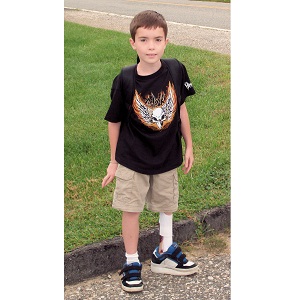
Introduction:
A leg length discrepancy is when there is a difference in the lengths of your two legs. In reality, this is a very common finding with a majority of people having at least some degree of difference. The discrepancy is usually very small and they compensate easily without even noticing. This would be considered a normal variation rather than a true problem. However, a larger difference can cause discomfort and affect function.
There are various reasons why a larger leg length discrepancy can occur, such as trauma/infection/diseases of the bone during childhood, neurological disorders or congenital discrepancies as a result of various conditions that are present at birth and get larger over time.
Many children with sacral agenesis have shorter legs than usual as a result of nerve differences/disruption that happened alongside the bone anomalies of the sacrum. Usually both legs are affected evenly, and you don’t end up with a discrepancy or if you do, it is very small. My son was missing the left half of his sacrum, which is less common than missing entire bony sections evenly from the bottom up. For us, this meant that the right side of his pelvis and the right leg had minimal disruption and developed in a normal manner. The left side, however, was smaller from the pelvis (which attached to his lumbar spine) down to the bones of his clubfoot. We noticed immediately after birth that he had a leg length discrepancy. Our orthopedic surgeon informed us that the left leg would likely remain the same percentage smaller than the other leg as he grew. He noted that the discrepancy would appear much larger as he got older and the legs became longer as “ten percent of a baby’s leg looks much smaller than ten percent of an adult leg.” He started out with an approximately 1/2cm discrepancy at birth. By one year old, it had doubled to 1cm and after that it slowly grew until he was about 6 years old when it stabilized at 4.5cm for a couple years. At age ten, with renewed growth it started increasing again and jumped to 6cm by age 11 and a half. At that point we opted for leg lengthening surgery as his shoelift became cumbersome and heavy. He wore an external fixator for six months and gained 6.3cm in length. However, due to his age at the time of surgery and further growth potential, his leg now has a discrepancy of approximately 2cm but he is happy with a shoelift at this point. For us, the surgery was well worth the time and effort that went into the process.
Treating leg length discrepancies:
In general, there are several ways to treat a leg length discrepancy. While the hip, knee and ankle joints are taken into consideration, the treatment recommendations mainly have to do with how large the expected discrepancy will be when a child is done growing. Doctors will follow your child to see if the discrepancy stays the same or if it is increasing, and after taking several measurements over a period of time, they will be able to predict how large the difference will be.
For those who are expected to have a less than 2cm difference, generally nothing is done. Many people walk around with differences like this and never know it. As a discrepancy usually develops slowly over time, it would be very hard to notice this in a young child.
With a slightly larger range of 2-5cm, you have both surgical and nonsurgical options. Nonsurgical treatment focuses on adding a lift either inside the shoe or on the sole of the shoe worn on the shorter leg. This helps balance the body out, makes it easier to walk and run, while protecting the knee and hip joints and giving proper spinal alignment to avoid back pain. If you are on the shorter side of that range, a shoe lift is probably all you will need.
However, for those predicted to reach the upper end, when shoe lifts start to become larger, there is a process called epiphysiodesis which can be performed. This surgery is performed with small incisions around the knee area, and it affects one of the growth plates in the longer leg so it will grow more slowly, allowing the shorter leg to “catch up.” This surgery is carefully timed after lots of observation of the discrepancy, with the goal of having both legs the same by the end of the growth period in mid to late teen years.
There are pros and cons to this surgery. An advantage is it is a fairly minor surgery and you no longer need a shoe lift after growth is done if all goes well. The cons are that you can over or under correct the length if the timing is off, you sacrifice height in the longer leg, and shortening too much can make the leg proportions look off. Wearing a smaller shoe lift if the discrepancy isn’t totally corrected isn’t bad, but you could potentially need one on the longer leg if too much correction is achieved.
For those that will have a larger discrepancy at full growth, surgical lengthening is usually the treatment of choice, with the exception of those who will have extreme discrepancies of 20+cm. For those extreme discrepancies, usually from congenital conditions like fibular hemimelia or proximal femoral focal deficiency, it is recommended to amputate at some point of the leg and fit for a prosthetic. For those in the 5-20cm range, leg lengthening or a combination of lengthening the shorter leg and slowing growth of the longer is usually done.
There are several methods of leg lengthening that are available currently. Some are internal and some external. With external lengthening, a device called a fixator is applied to the area of the leg to be lengthened. The fixator is a scaffold like frame that either goes around the leg, or has a rigid bar alongside the leg. While in surgery, the bone is cut, and screws are placed on either side of the cut bone and connected to the fixator. Multiple wires also will be placed into the bones to support the frame. After some initial healing, dials on the fixator are gradually turned to slowly pull apart the cut bone, allowing new bone to fill in the space. This is done until you have gained the needed length. Usually you lengthen 1mm total per day, divided into smaller amounts several times during that day. This is the amount that the body can produce new bone, without it either separating totally or healing together too quickly. For those with potential blood vessel or muscle abnormalities, you may need to go a bit slower but your doctor will help with that. This will grow the leg approximately 1 inch per month. After you reach the desired length, the fixator is “locked” in place and the new bone is allowed to heal until strong enough to support weight bearing without the fixator. A typical rule of thumb is that it takes as long to heal the bone as it did to grow it. After that, the fixator will be removed during surgery, and a cast will be placed to allow the holes in the bone to fill in. This method gives you precise control over lengthening, and can correct problems in a three dimensional space, such as when you are lengthening but also changing rotation or angle of the leg or foot at the same time, which is a big plus with multiple leg issues. A disadvantage is of course, having the large frame on the leg, and needing to take good care of the pin and wire holes in the leg to avoid infection.
Another method of lengthening is internal, using expandable metal rods that are placed inside the bone. Because the internal rod provides stability, you don’t need any support from the outside. A big advantage of this is that you don’t need an external fixator, so you avoid the infection risks associated with that, and the physical and psychological issues that come with it. A previous disadvantage has been that you could not control growth as precisely as you could with the external fixator because it lengthened using body movements, which could be unpredictable. A newer method called Precise now uses magnets that can be lengthened with a portable machine that is pre-programmed by the doctor, and this has greatly helped. There is still the disadvantage of not being able to address three dimensional issues, like rotation or foot anomalies at the same time, only leg length and the fact that the rod needs another surgery for removal a year or so afterwards.
With either method of lengthening chosen, there is still a big time commitment for doctor visits and physical therapy. The leg will need to be monitored throughout the growth phase to make sure new bone is forming at a good pace and that the density is increasing as expected, to see if any modifications in the treatment plan are needed. Intense physical therapy is necessary to make sure that the muscles and tendons do not lose their range of motion during the lengthening, as the soft tissues can lengthen more slowly than the bone. You do not want to risk joint contractures from lengthening too fast while not having enough physical activity to keep pace. Also, knee stiffness after the final cast comes off is expected, and PT will need to be done to regain full range of motion.
Complications are common with leg lengthening, and it’s more a mentality of being ready to manage them than expecting to fully prevent them. The most common issues you face are pin site infections (we had three), joint stiffness/contracture and being off a bit on the length.
Further information:
This is just a general overview of leg length discrepancy and treatment. For more detailed information on discrepancies, leg lengthening and my day to day “in the trenches” description of what it was like to go through the leg lengthening process, pictures of before and after surgery, along with helpful links for those who want more in depth knowledge, you can visit Connie Morrisroe’s webpage here: Life with a leg length discrepancy .
Sources:
https://posna.org/Physician-Education/Study-Guide/Leg-Length-Discrepancy
http://orthoinfo.aaos.org/topic.cfm?topic=a00259
http://www.lifebridgehealth.org/RIAO/LimbLengthDiscrepancyLLD.aspx
